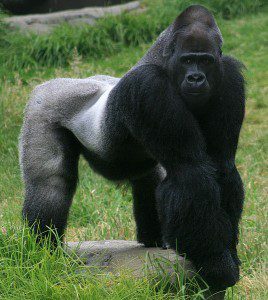The Day I Touched Cocoa the Gorilla
A long time ago in a college far, far away, I was an anthropology major at a conservative Christian college in Minnesota. I owe the discipline of anthropology my life, as it transformed me from being a Pharisee among Pharisees to the “adjusted human being” that I am today.
My most memorable ‘anthropological moment’ came in my junior year when my beloved professor, Dr. James P. Hurd, took my class to Como Zoo to “visit the apes” for a Physical Anthropology field trip. I imagine that most of my readers have never been up close and personal to any large primates (unless they happen to know any SEC offensive linemen). We were “taken below” to the feeding level, and each of us had the opportunity to make literal contact with the gorillas, orangutans, and chimpanzees which stared at us mournfully from beyond their barred containment.
I straggled behind the group in order to have more intimate contact with my distant relations from whom I had been disconnected for several million years. At one point, I found myself standing completely alone with a gargantuan silverback gorilla named Cocoa. We stared at each other inquisitively, and for a moment I could not tell who was watching whom.
Quite unexpectedly, Cocoa held out his hand to me between the thick black bars, and we touched each other. It is difficult to explain how connected I felt, but at that moment I finally became convinced that humans are, in reality, animals. (Apologies to the imago Dei).
There is a people group in northwestern South America known as the Yanomamo. Translated, this word comes out something like “the fierce people.” Yanomamo men partake in a peculiar Rochambeau-like cultural phenomena, where, before everyone in the tribe, one man suddenly walks up to another man with a gigantic wooden club and smashes him on the chest. All is good and well for the man who is the smasher; that is, until the smashee recovers from his near-fatal wound, finds his own club, and returns the smash as is his cultural privilege.
This exchange of blows continues until either one of the men is dead or can hardly continue breathing. Needless to say, it is at this moment that Yanomamo women thank their lucky stars that their culture yet knows no such a thing as gender equity.
Structural theories of culture seem to support the idea that, given a particular culture phenomena such as chest-combat among the Yanomamo, every other culture should have a phenomena that roughly compares as an equivalent.
My friend Jonathon Moore and I considered the matter and discovered the Western counterpart to this horrific Rochambeau-ing act of the Yanomamo: mainly, cinematic name-dropping.
Perhaps you have observed the following:
Guy 1: Hey, that reminds me of that one scene from Monty Python and the Holy Grail.
Guy 2: Oh, you mean, “Your mother was a hamster and your father smelled of elderberries.”
Guy 1 and Guy 2: Chortle, chortle, chortle.
Guy 2: But that isn’t anything like that scene from Planes, Trains, and Automobiles.
Guy 1: That’s right! “Those aren’t pillows.”
Guy 1 and Guy 2: Guffaw, guffaw, guffaw.
Name-dropping is a common posturing mechanism in the West, and, to my knowledge, I am the first person to posit that such actions are linked directly to the courtship behavioral process. Why do men (especially) feel an uncontrollable urge to quote their favorite parts of movies and books? The answer is obvious: to attract the mate who will recognize the male with the more superior grip on fashionable knowledge.
All male species of animals are equipped with the biological weaponry to battle their fellow comrades for the hand of a lovely maiden, whether it be in the form of colorful plumage for a bird or the suffused silver back of the most dominant gorilla.
Humans have inherited this framework of behavior for whatever reasons, and I think that it is important to recognize what is going on here. Apparently, the more a guy can out-quote another guy’s knowledge of film or sports or whatever, the more radiant his plumage appears to the society of women he is trying to impress. Even when guys are in the company of other guys, they still do this, and as my friend and I came to the conclusion, it is for the express purpose of humiliating other men so that their public actions will appear more inhibited and psychologically inferior to the women for whom they will eventually compete.
…
Conclusion: I wrote this article for the Wheaton Record way back when in February 1996. It was fun to stumble upon this clip the other day and clean it up a bit for my blog. I’m not really sure that I made a proper connection between Cocoa and the Yanomamo–in fact, I know I didn’t. But I was in the early stages of learning the craft of writing, so I forgive myself.
I still vividly remember touching Cocoa’s hand and studying its fingernails and ears; so very, very human-like. And I remember what it was like to make mental connections for the first time between animal and human behavior. I look back on this article as the “first stone in the pyramid.” It informed all future literary directions.
Some authors coil up like threatened snakes at the sight of a piece of juvenilia. I don’t. I owe Cocoa the Gorilla and Dr. Hurd a great debt of thanks for helping to shape my creative mind.
Thus, I’m proud to make this article my first official blog.
- Posted by
 Arik Bjorn
Arik Bjorn - Posted in Arik's Blog
 Dec, 09, 2013
Dec, 09, 2013 No Comments.
No Comments.
I think Uber Nights is the perfect bathroom book. If there are any public libraries out there listening, I think they should put a copy in every stall.
-Read more about Uber Nights



